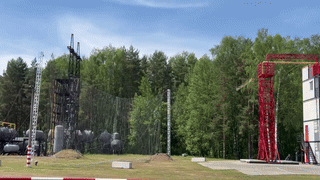Russia Tests Anti-Drone Nets to Shield Refineries from Ukrainian Attacks

Russia tests anti-drone nets to catch Ukrainian drones attacking refineries, aiming to detonate them before reaching their targets. These nets offer a new defense layer but may not stop high-speed drones or coordinated attacks.
Russia has been showcasing test flights involving anti-drone nets, a new defense mechanism designed to safeguard refineries and oil depots from Ukrainian drone strikes. While the test drone undeniably flies at a slower pace than real-world models, the developers are on the right track. Their goal: to ensnare the drone and trigger its detonation at a safe distance, effectively neutralizing the attack.
This development comes after a string of successful drone assaults by Ukraine on critical Russian oil infrastructure. The vulnerability of these refineries prompted a search for countermeasures, and anti-drone nets have emerged as a potential solution.
Here's a closer look at this defense system:
- Physical Barrier: The net acts as a physical obstacle, designed to snag the drone mid-flight. This disrupts its trajectory and prevents it from reaching its target.
- Detonation at a Distance: Ideally, upon getting caught in the net, the drone's explosive payload would detonate before reaching the intended target. This significantly reduces the potential damage to the refinery.
Limitations to Consider:
While anti-drone nets offer a layer of protection, they aren't foolproof. Here are some limitations to keep in mind:
- Drone Speed: The effectiveness of the net relies heavily on the drone's speed. The test video likely used a slower drone than those typically deployed in attacks. High-speed drones might have a higher chance of breaching the net.
- Multiple Drones: A coordinated attack with multiple drones could overwhelm the net's defensive capabilities.
- Evolving Technology: As drone technology advances, so too must countermeasures. The developers need to stay ahead of the curve and adapt the nets to handle new threats.
Alternative Defense Measures:
Anti-drone nets represent one approach to protecting critical infrastructure. Other methods include:
- Electronic Warfare: Jamming drone control signals can disrupt communication between the operator and the drone, potentially disabling it.
- Drone Interception: Deploying interceptor drones specifically designed to take down attacking drones is another option.
- Surface-to-Air Missiles: For high-threat environments, surface-to-air missiles offer a more robust defense, but come with a higher cost.
The Future of Drone Defense:
The use of drones in warfare is a growing concern, and protecting critical infrastructure from these aerial threats is a top priority. Anti-drone nets offer a promising, though not infallible, solution. Continued development and a multi-layered defense strategy will be crucial in safeguarding refineries and other vital assets.


